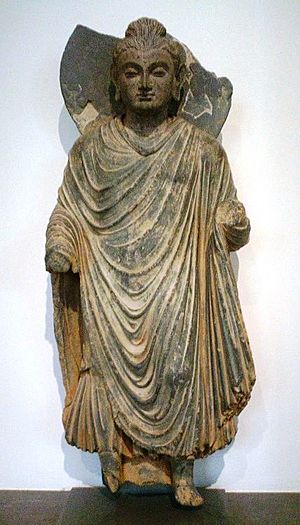Buddhism in Pakistan facts for kids
Today, there are very few Buddhists living in Pakistan. However, this region was once a very important place for Buddhism. A small number of Buddhists might still live in Pakistani Kashmir. There is a larger Buddhist community in Jammu and Kashmir, which is to the east of the Line of Control. These people are often from Ladakh and are related to Tibetans.
Contents
Buddhism's Past in Pakistan

The area we now call Pakistan used to have many Buddhists. Most people in Gandhara were Buddhist. Gandhara covered parts of what is now North Western Pakistan and Eastern Afghanistan. It was a major center for Mahayana Buddhism and also for Vajrayana Buddhism.
The Swat Valley, known long ago as Uddiyana, was a kingdom connected to Gandhara. You can find many old Buddhist sites in Swat.
Important Buddhist Figures
A famous Buddhist teacher named Padmasambhava is believed to have been born near Chakdara. This town is in the Lower Dir District, which was part of Uddiyana back then. Padmasambhava is also called Guru Rinpoche in Tibet. He was the one who brought Vajrayana Buddhism to Tibet.
Buddhism Across the Region
Buddhism was also practiced in the Punjab and Sindh areas of Pakistan.
Gandhara remained a mostly Buddhist land until about 800 AD. Around that time, the Pashtun people came from Southern Afghanistan. They brought the Islamic religion with them.
In Punjab, many Buddhists changed their religion to Hinduism starting around 600 AD. In Sindh, most people were Buddhist until the Arab conquest in 710 AD by the Umayyads. After Pakistan and India became separate countries, many Buddhists moved to India. This was similar to what happened with Hindus, Sikhs, and Christians in the Pakistan region.
Images for kids
-
Statue of a Buddha seated on a lotus throne in Swat, Pakistan.
-
Bronze statue of Avalokiteśvara Bodhisattva from Gandhara. 3rd–4th century.
-
Buddha from the Kahu-jo-daro stupa displayed in Chhatrapati Shivaji Maharaj Vastu Sangrahalaya.
-
A statue of Buddha (at Jaulian, Taxila) with a hole in the navel is an odd artifact. It is called the "Healing Buddha". Buddhist pilgrims put their fings in the navel hole and pray for the ailment of the patients.













